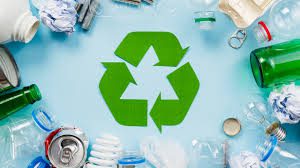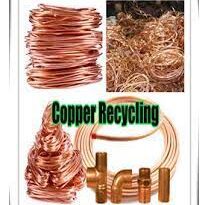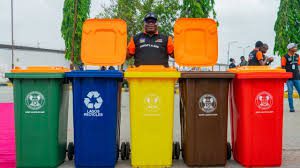Materials Recycling Process and Steps in Paper Recycling
1. Paper Recycling
This is the process of turning waste paper into new paper products.
There are three categories of paper that can be used as feed stocks for making recycled paper: mill broke pre-consumer waste, and post- consumer waste. The process of paper recycling involves mixing used paper with water and chemicals to break the paper down.
The paper is then chopped up and heated, which breaks the paper down further into strands of cellulose, which is a type of organic plant material from the pulp.
The resulting mixture called slurry is strained through screens, which remove any glue or plastic that may still be in the mixture then cleaned, de-inked, bleached, and mixed with water.
Then this can be made into new paper. The same fibers can be recycled about seven times, but they get shorter every time and eventually are strained out.
Mill broke is paper trimmings and other paper scrap from the manufacture of paper, and the paper recycled internally in a paper mill. Pre consumer waste is material which left the paper mill but was discarded before it was ready for consumer use.
Post-consumer waste is material discarded after consumer use, such as old corrugated containers, old magazines, old newspapers, office paper, old telephone directories, and residential mixed paper.
Read Also : Strategies for Carrying out Waste Recycling
Paper suitable for recycling is called “scrap paper”, often used to produce molded pulp packaging. The industrial process of removing printing ink from paper fibers of recycled paper to make deinked pulp is called deinking, an invention of the German Jurist Justus Claproth.

Steps in Paper Recycling
Here is how paper waste is recycled:
1. Collection,Transportation and Storage
The biggest task for paper recycling companies is probably the collection, transporting and sorting of waste paper. This is because we always add paper to other waste items and get them contaminated with food, plastics and metals.
Sometimes collected paper is sent back to the landfills because they are too contaminated for use. Try to keep waste paper in separate grades at home or in the office example, do not mix newspapers and corrugated boxes up.
Fig: Types of Recycled Papers

All paper recovered is sent to the recycling center, where it is packed, graded, put into bales and sent to the paper mill. At the mill, all the paper is stored in a warehouse until it is needed.
2. Repulping and Screening
From the storage shelves, they are moved into a big paper-grinding machine called a vat (pulper).
Here the paper is chopped into tiny pieces, mixed with water and chemicals and heated up to break it down into organic plant material called fibre. After, it is screened to remove contaminants such as bits of plastic and globs of glue.
3. Deinking
This involves ‘washing’ the pulp with chemicals to remove printing ink and glue residue. Sometimes, a process called floatation is applied to further remove stubborn stains and stickies.
Floatation involves the use of chemicals and air to create bubbles which absorb the stickies in the pulp.
4. Refining, Bleaching and Color Stripping
Refining involves beating the recycled pulp to make them ideal for paper-making. After refining, additional chemicals are added to remove any dyes from the paper. It is then bleached to whiten and brighten it up.
5. Paper Making
At this stage, the pulp is ready to be used for paper. Sometimes new pulp (virgin pulp) is added to give it extra strength and smoothness. Water is added to the pulp and sprayed onto a large metal screen in continuous mode.
The water is drained on the screen and the fibres begin to bond with each other. As it moves through the paper-making machines, press rollers squeeze out more water, heat them dry and coat them up. They are then finished into rolls.
6. Aluminum Recycling
In recent time, there has been a massive improvement in recycling aluminum cans. In 2003, it was reported that Americans recycled 62.6 billion aluminum cans.
Those cans, placed end-to-end, could make 171 circles around the earth. Every minute an average of 105,800 aluminum cans are recycled.
That is how important can recycling has become. But what is involved here?
7. Collection
Local councils provide special can recycling containers (bins) that are clearly marked. This helps people to know what to place in them. The various cans include soda cans, fruit cans and vegetable cans.
Trucks come for these at pick up spots to the recycling centres. Cans may also be metallic or steel, but people do not know the difference.
8. Preparation
At the collection center, a huge magnet is rolled over them as they move on the conveyor belt to pull out all the metal and steel cans.
Only the aluminum cans are washed, crushed, condensed in to 30-pounds briquettes for other companies for further processing. The rest is also sorted and sent to their appropriate recycling centres.
9. Melting
The crushed cans are loaded into a burning furnace, where all printing and designs on the cans are removed, melted and blended with new (virgin) aluminum.
The molten (liquid) aluminum is poured into moulds and made into bars called ingots.
10. Sheets
The ingots are then fed into powerful rollers, which flatten them into thin sheets of aluminum of about 25.4 in thickness. These thin sheets are rolled into coils and sold or sent to can-making factories.
Read Also : Strategies for Carrying out Waste Recycling
They use the aluminum coils to prepare cans and containers for other food and drink manufacturers. It is estimated that cans collected at collection points take up to 60 days to be appear in the shops again as new cans containing your favorite soda, juice or food.



